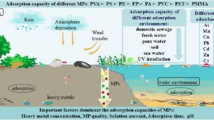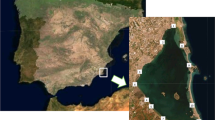Abstract
Knowledge of phosphorus (P) components in water is vital to understanding the biogeochemistry of the P cycle, but little information is available about P, especially organic P components in water. We used solution 31P nuclear magnetic resonance technology (31P NMR) to characterize the classes of dissolved and particulate P compounds, as well as their spatial variation, in eutrophic Lake Taihu, Eastern China. Results showed that orthophosphate and monoesters were the dominant components in dissolved and particulate P. The main difference between the classes of dissolved and particulate P compounds was that phosphonate was detected in dissolved P, whereas pyrophosphate was mainly found in particulate P. The proportions of various classes of P compounds in particulate total P were relatively stable, which may be partly attributed to phytoplankton. In dissolved total P (DTP), the proportions of orthophosphate and monoester varied substantially and were significantly correlated with DTP concentration. According to the source of P and the ratios of dominant classes of P compounds in dissolved and particulate P, the dissolved orthophosphate may be substantially influenced by pollution sources, and other P compounds are mainly controlled by biological transformation processes.







Similar content being viewed by others
References
Ahlgren J, Tranvik L, Gogool A, Waldeback M, Markides K, Rydin E (2005) Sediment depth attenuation of biogenic phosphorus compounds measured by 31P NMR. Environ Sci Technol 39:867–872
Ahlgren J, Reitzel K, Tranvik L, Gogoll A, Rydin E (2006) Degradation of organic phosphorus compounds in anoxic Baltic Sea sediments: a P-31 nuclear magnetic resonance study. Limnol Oceangor 51:2341–2348
Ammerman JW, Azam F (1985) Bacterial 5′-nucleotidase in aquatic ecosystems: a novel mechanism of phosphorus regeneration. Science 227:1338–1340
Bai XL, Ding SM, Fan CX, Liu T, Shi D, Zhang L (2009) Organic phosphorus species in surface sediments of large, shallow, eutrophic lake, Lake Taihu, China. Environ Pollut 157:2507–2513
Bai XL, Zhou YK, Sun JH (2014) Optimization of dissolved nonreactive phosphorus concentration in water of Lake Taihu for 31P-NMR analysis. J Instrum Anal 33:1078–1082 (in Chinese)
Benitez-Nelson CR (2000) The biogeochemical cycling of phosphorus in marine systems. Earth-Sci Rev 51:109–135
Cade-Menun BJ (2005) Characterizing phosphorus in environmental and agricultural samples by 31P nuclear magnetic resonance spectroscopy. Talanta 66:359–371
Cade-Menun BJ, Navaratnam JA, Walbridge MR (2006) Characterizing dissolved and particulate phosphorus in water with 31P nuclear magnetic resonance spectroscopy. Environ Sci Technol 40:7874–7880
Cheesman AW, Turner BJ, Reddy KR (2012) Soil phosphorus forms along a strong nutrient gradient in a tropical ombrotrophic wetland. Soil Sci Soc Am J 76:1496–1506
Chen YW, Gao XY (2000) Comparison of two methods for phytoplankton chlorophyll a concentration measurement. J Lake Sci 12:185–188 (in Chinese)
Clark LL, Ingall ED, Benner R (1999) Marine organic phosphorus cycling: novel insights from nuclear magnetic resonance. Am J Sci 299:724–737
Ding SM, Bai XL, Fan CX, Zhang L (2010) Caution needed in pretreatment of sediments for refining phosphorus-31 nuclear magnetic resonance analysis: results from a comprehensive assessment of pretreatment with ethylenediaminetetraacetic acid. J Environ Qual 39:1668–1678
Ding SM, Xu D, Bai XL, Yao SC, Fan CX, Zhang CS (2013) Speciation of organic phosphorus in a sediment profile of Lake Taihu II. Molecular species and their depth attenuation. J Environ Sci 25:925–932
Doolette AL, Smernik RJ, Dougherty WJ (2009) Spiking improved solution phosphorus-31 nuclear magnetic resonance identification of soil phosphorus compounds. Soil Sci Soc Am J 73:919–927
Duan HT, Ma RH, Xu XF, Kong FX, Zhang SX, Kong WJ, Hao JY, Shang LL (2009) Two-decade reconstruction of algal blooms in China’s Lake Taihu. Environ Sci Technol 43:3522–3528
Dyhrman ST, Benitez-Nelson CR, Orchard ED, Haley ST, Pellechia PJ (2009) A microbial source of phosphonates in oligotrophic marine systems. Nat Geosci 2:696–699
Gao YX, Cai LL, Zhao LL, Zhu GW (2011) Water quality comparison between Lake Taihu and contribute river during high water-level period. Environ Sci 32:2840–2848 (in Chinese)
Giles CD, Cade-Menun BJ (2014) Phytate in animal manure and soils: abundance, chemistry and bioavailability. In: He Z, Zhang H (eds) Applied manure and nutrient chemistry for sustainable agriculture. Springer, New York
Glibert PW, Heil CA, Hollander DJ, Revilla M, Hoare A, Alexander J, Murasko S (2004) Evidence for dissolved organic nitrogen and phosphorus uptake during a cyanobacterial bloom in Florida Bay. Mar Ecol Prog Ser 280:73–83
He ZQ, Griffin TS, Honeycutt CW (2003) Enzymatic hydrolysis of organic phosphorus in swine manure and soil. J Environ Qual 33:367–372
Hupfer M, Gächter R, Rűegger H (1995) Polyphosphate in lake sediments: 31P NMR spectroscopy as a tool for its identification. Limnol Oceanogr 40:610–617
Hupfer M, Gloess S, Grossart HP (2007) Polyphosphate-accumulating microorganisms in aquatic sediments. Aquat Microb Ecol 47:299–311
Jørgensen C, Jensen HS, Andersen FO, Egemose S, Reitzel K (2011) Occurrence of orthophosphate monoesters in lake sediments: significance of myo- and scyllo-inositol hexakisphosphate. J Environ Monit 13:2328–2334
Kittredge JS, Roberts E (1969) A carbon-phosphorus bond in nature. Science 164:37–42
Kolowith LC, Ingall ED, Benner R (2001) Composition and cycling of marine organic phosphorus. Limnol Oceanogr 46:309–320
Løvdal T, Tanaka T, Thingstad TF (2007) Algal-bacterial competition for phosphorus from dissolved DNA, ATP, and orthophosphate in a mesocosm experiment. Limnol Oceanogr 52:1407–1419
Ma Q, Liu JJ, Gao MY (2010) Amount of pollutants discharged into lake Taihu from Jiangsu Province, 1998-2007. J Lake Sci 22:29–34 (in Chinese)
Makarov MI, Haumaier L, Zech W (2002) Nature of soil organic phosphorus: an assessment of peak assignment in the diester region of 31P-NMR spectra. Soil Biol Biochem 34:1467–1477
Martinez A, Tyson GW, DeLong EF (2010) Widespread known and novel phosphonate utilization pathways in marine bacteria revealed by functional screening and metagenomic analyses. Environ Microbiol 12:222–238
Monaghan EJ, Ruttenberg KC (1999) Dissolved organic phosphorus in the coastal ocean: reassessment of available methods and seasonal phosphorus profiles from the Eel River Shelf. Limnol Oceangor 44:1702–1714
Monbet P, Mckelvie ID, Saefumillah A, Worsfold PJ (2007) A protocol to assess the enzymatic release of dissolved organic phosphorus species in waters under environmentally relevant conditions. Environ Sci Technol 41:7479–7485
Monbet P, McKelvie ID, Worsfold PJ (2009) Dissolved organic phosphorus speciation in the waters of the Tamar estuary (SW England). Geochim Cosmochim Acta 73:1027–1038
Murphy J, Riley JP (1962) A modified single-solution method for the determination of phosphate in nature waters. Anal Chim Acta 27:31–36
Namikoshi M, Rinehart K (1996) Bioactive compounds produced by cyanobacteria. J Ind Microbiol Biotechnol 17:373–384
Nanny MA, Minear RA (1997) Characterization of soluble reactive phosphorus using 31P nuclear magnetic resonance spectroscopy. Mar Geol 139:77–94
Nanny MA, Kim S, Minear RA (1995) Aquatic soluble unreactive phosphorus: HPLC studies on concentrated water samples. Water Res 29:2138–2148
Newman RH, Tate KR (1980) Soil phosphorus characterization by 31P nuclear magnetic resonance. Commun Soil Sci Plan 11:835–842
Pang XH, Lv LY, Niu Y, Shen H, Yuan XG, Chen WJ, Chen J, Xie P (2014) The spartial pattern of bacterioplankton community composition in Lake Taihu in summer. Acta Hydrobiol Sin 38:335–341 (in Chinese)
Qin BQ, Hu WP, Chen WM (2004) Process and mechanism of environment changes of the Lake Taihu. Science Press, Beijing (in Chinese)
Read EK, Ivancic M, Hanson P, Cade-Menun BJ, McMahon KD (2014) Phosphorus speciation in a eutrophic lake by 31P NMR spectroscopy. Water Res 62:229–240
Reddy KR, DeLaune RD (2008) Phosphorus forms in water column and soil. In: O’Connor GA, Schelske CL (eds) Biogeochemistry of wetlands: science and application. CRC Press, Boca Raton
Reitzel K, Ahlgren J, DeBrabandere H, Waldebäck M, Gogoll A, Tranvik L, Rydin E (2007) Degradation rates of organic phosphorus in lake sediment. Biogeochemistry 82:15–28
Reitzel K, Henning SJ, Mogens F, Andersen F (2009) Identification of dissolved nonreactive phosphorus in freshwater by precipitation with aluminum and subsequent 31P-NMR analysis. Environ Sci Technol 43:5391–5397
Rinker KR, Powell RT (2006) Dissolved organic phosphorus in the Mississippi River plumne during spring and fall 2002. Mar Chem 102:170–179
Rosenberg H, LaNauze JM (1967) The metabolism of phosphonates by microorganisms. The transport of aminoethyl-phosphonic acid in Bacilus cereus. Biochim Biophys Acta 141:79–90
Selig U, Hubener T, Michalik M (2002) Dissolved and particulate phosphorus forms in a eutrophic shallow lake. Aquat Sci 64:97–105
Shinohara R, Imai A, Kawasaki N, Komatsu K, Kohzu A, Miura S, Sano T, Satou T, Tomioka N (2012) Biogenic phosphorus compunds in sediment and suspended particles in a shallow eutrophic lake: a 31P-Nuclear Magnetic Resonance (31P NMR) study. Environ Sci Technol 46:10572–10578
Sundareshwar PV, Morris JT, Pellechia PJ, Cohen HJ, Porter DE, Jones BC (2001) Occurrence and ecological implications of pyrophosphate in esturies. Limnol Oceanogr 46:1570–1577
Turner BL, Weckstrom K (2009) Phytate as a novel phosphorus-specific paleoindicator in aquatic sediments. J Paleolimnol 42:391–400
Turner BL, Mahieu N, Condron LM (2003a) Phosphorus-31 nuclear magnetic resonance spectral assignments of phosphorus compounds in soil NaOH-EDTA extracts. Soil Sci Soc Am J 67:497–510
Turner BL, Mahieu N, Condron LM (2003b) The phosphorus composition of temperate pasture soils determined by NaOH-EDTA extraction and solution 31P NMR spectroscopy. Org Geochem 34:1199–1210
Wang XJ, Ding SM, Jiang HQ, Bai XL, Fan CX (2008) Characterizing phosphorus in environmental model samples by 31P-NMR. J Lake Sci 20:45–50 (in Chinese)
Wang ZH, Liang Y, Kang W (2011) Utilization of dissolved organic phosphorus by different groups of phytoplankton taxa. Harmful Algae 12:113–118
Wetzel RG (2001) The phosphorus cycle. In: Pace ML, Groffmann PM (eds) Limnology, lake and river ecosystem. Academic Press, San Diego
Worsfold PJ, Monbet P, Tappin AD, Fitzsimons MF, Stiles DA, McKelvie LD (2008) Characterisation and quantification of organic phosphorus and organic nitrogen components in aquatic systems: a review. Anal Chim Acta 624:37–58
Xu H, Parel HW, Qin BQ, Zhu GW, Gao G (2010) Nitrogen and phosphorus inputs control phytoplankton growth in eutrophic Lake Taihu, China. Limnol Oceanogr 55:420–432
Yan SW, Yu H, Zhang LL, Xu J, Wang ZP (2011) Water quantity and pollutant fluxes of inflow and outflow rivers of Lake Taihu, 2009. J Lake Sci 23:855–862 (in Chinese)
Yoshimura T, Nishioka J, Saito H, Takeda S, Tsuda A, Wells ML (2007) Distributions of particulate and dissolved organic and inorganic phosphorus in North Pacific surface waters. Mar Chem 103:112–121
Zhang RY, Wang LY, Wu FC, Song BA (2013) Phosphorus speciation in the sediment profile of Lake Erhai, southwestern China: fractionation and 31P-NMR. J Environ Sci 25:1124–1130
Zhu GW, Qin BQ, Gao G (2005) Direct evidence for phosphorus flux from the sediments in big, shallow lake by wind disturbance. Sci Bull 50:66–71 (in Chinese)
Acknowledgments
We thank the Taihu Laboratory for Lake Ecosystem Research for assistance with sampling and chemical analysis. We also acknowledge Prof. Shiming Ding for the constructive suggestions on manuscript revision and Zhihong Liang for 31P NMR analysis. This work was supported by National Natural Science Foundation of China (No. 41001319, 41101089, 41371450 and 41201535).
Author information
Authors and Affiliations
Corresponding author
Additional information
Responsible Editor: C.T. Driscoll.
Rights and permissions
About this article
Cite this article
Bai, Xl., Zhou, Yk., Sun, Jh. et al. Classes of dissolved and particulate phosphorus compounds and their spatial distributions in the water of a eutrophic lake: a 31P NMR study. Biogeochemistry 126, 227–240 (2015). https://doi.org/10.1007/s10533-015-0155-7
Received:
Accepted:
Published:
Issue Date:
DOI: https://doi.org/10.1007/s10533-015-0155-7




